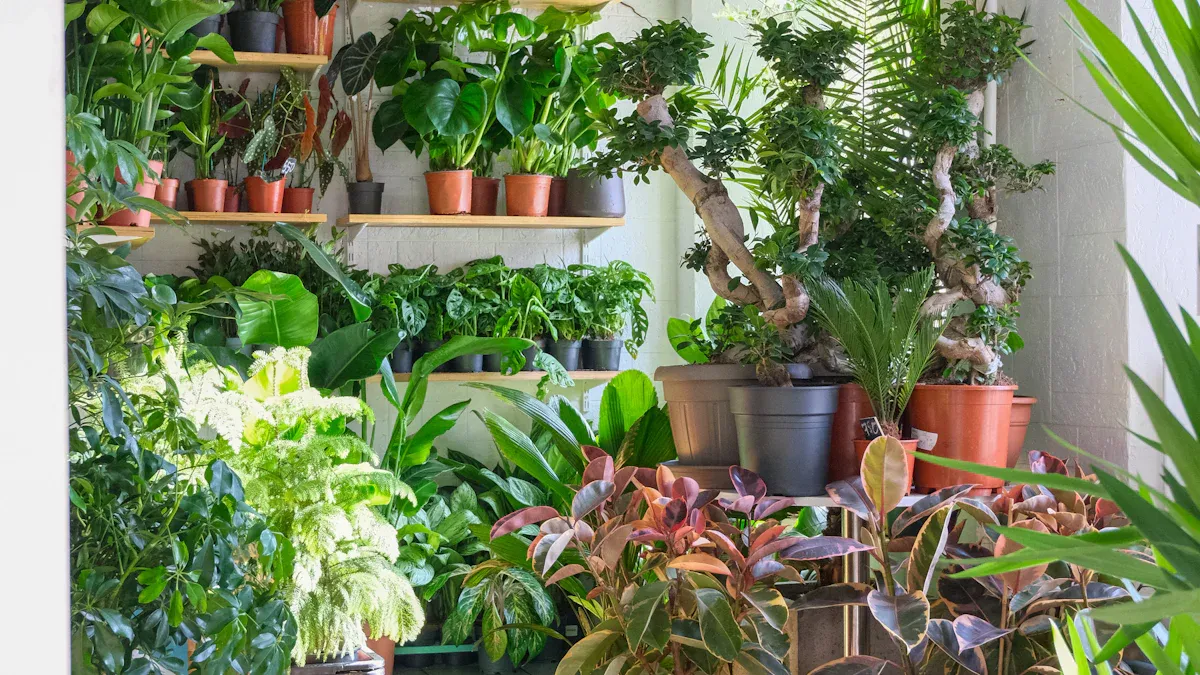
You can start apartment garden projects even if you live in a small space. Many people report that when you start an apartment garden, you feel less stress and enjoy better mental health. Apartment gardening lets you grow your own plants, which means fresher food and a healthier diet. You also get to move more, connect with others, and create a cozy space.
Apartment gardens use less water and space.
Indoor plants brighten rooms and clean the air.
You can start a garden with easy-to-grow plants like herbs or lettuce on a windowsill.
Key Takeaways
You can start an apartment garden in small spaces using windowsills, balconies, or vertical setups to grow fresh herbs, greens, and veggies.
Choose plants that fit your light conditions, like herbs and leafy greens for less sun, and fruiting vegetables for brighter spots.
Gather basic supplies like containers with drainage, potting soil, seeds, and watering tools to make gardening easy and fun.
Follow simple planting steps: use seed trays, water deeply, provide enough light, and fertilize regularly for healthy growth.
Use vertical gardening and smart container arrangements to save space, and care for plants by watering, pruning, and controlling pests naturally.
Find Your Space
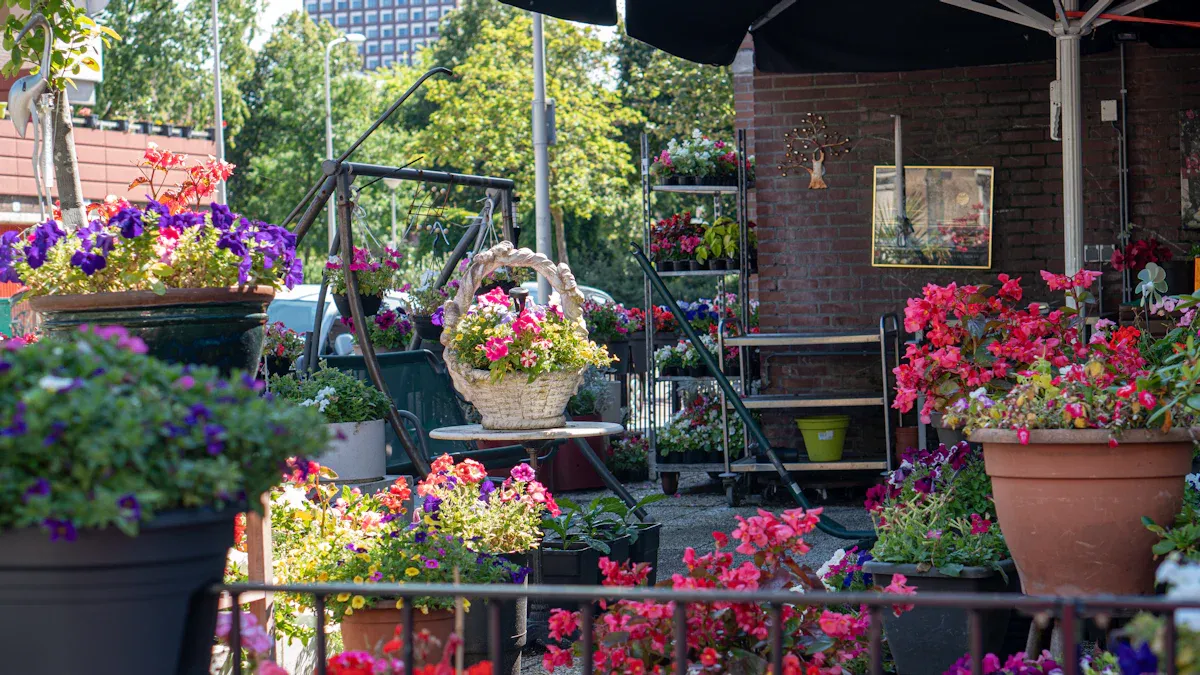
When you start apartment gardening, the first step is to look around and see what spaces you can use. You might be surprised by how many options you have, even in a small apartment. Here are some of the most popular spots people use for apartment garden ideas:
Windowsills with good sunlight
Balconies for outdoor containers or hanging baskets
Wall space for vertical gardens or trellises
Shelves and countertops for small pots or microgreen kits
Furniture like bookshelves or dressers for extra plant displays
Windowsills and Balconies
Windowsills work well for herbs, succulents, and leafy greens. They get natural light and fit small pots. Balconies give you more room for larger containers, stackable planters, or even a vertical garden tower. You can grow the best outdoor balcony garden plants, like tomatoes, peppers, or small fruit trees, if your balcony gets enough sun. Just check if your balcony can hold the weight of wet soil and containers. Watch out for strong winds, which can damage delicate plants.
Tip: Use hanging baskets or wall-mounted planters to save floor space and add more greenery.
Light and Sun
Plants need sunlight to grow. Most apartment gardening setups work best with at least 4 to 6 hours of sunlight each day. Fruiting plants, like tomatoes or peppers, need 6 to 8 hours. Herbs and leafy greens can do well with less, but more sun means bigger harvests. If your space does not get enough natural light, try using grow lights or choose shade-loving plants like snake plants or pothos.
Sunlight Hours | Plant Types & Growth Notes |
|---|---|
2 to 4 hours | Herbs like mint, chives, parsley; may survive but not thrive |
4 to 6 hours | Leafy greens such as lettuce, arugula, spinach; good growth |
6 to 8 hours | Root crops (carrots, radishes), bulbs (onions, garlic), leafy greens thrive |
8+ hours | Fruiting vegetables (tomatoes, peppers, eggplants) grow best |
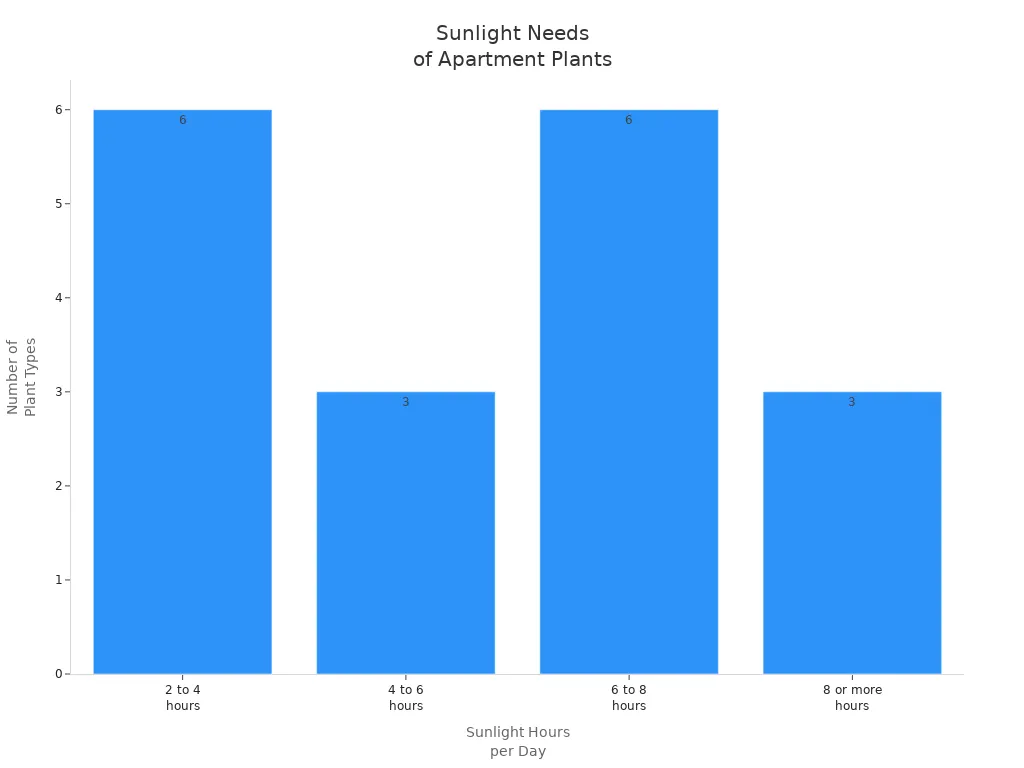
If you have limited light, vertical gardens, compact planters, and hydroponic systems help you grow more in less space. These ideas make apartment gardening possible in almost any home.
Choose Plants to Grow
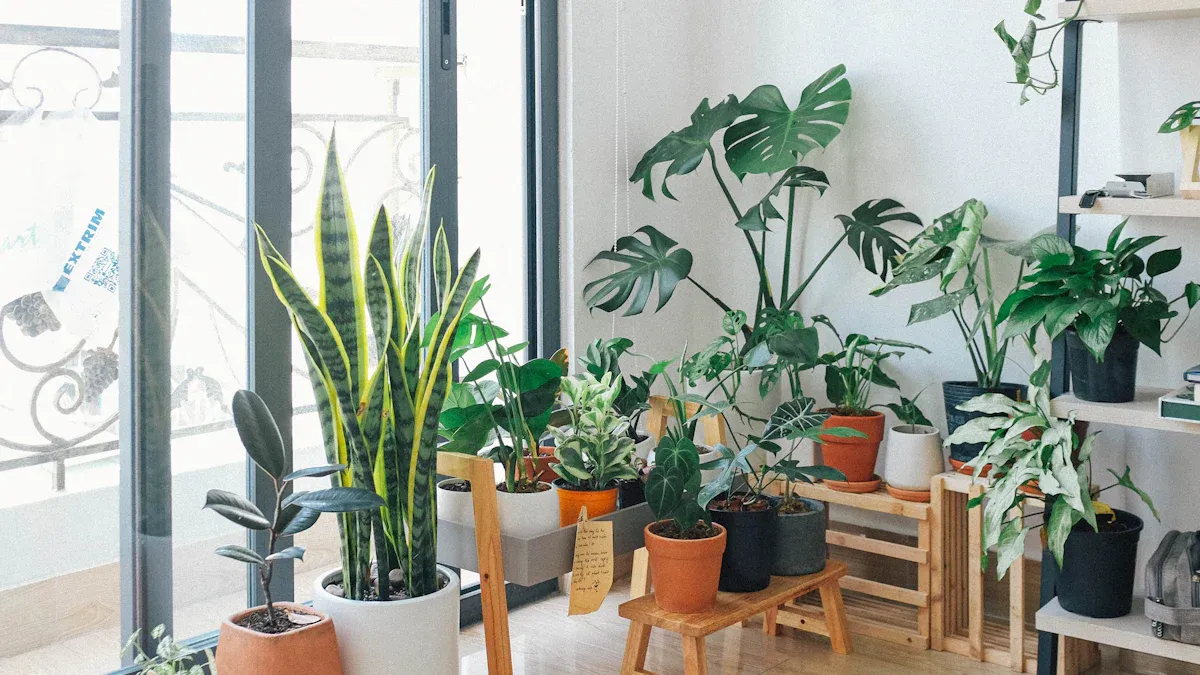
Choosing the right plants makes your indoor garden easy to start and fun to care for. You can pick from greens, herbs, compact veggies, flowers, and even air-purifying houseplants. Let’s look at what works best for small spaces.
Easy Greens and Herbs
You can grow many tasty greens and herbs in your indoor garden. These plants need little space and grow well in containers or even jars. Try these options:
Microgreens like peas, radishes, and lettuce (ready to harvest in 7–14 days)
Herbs such as basil, cilantro, mint, parsley, chives, dill, oregano, thyme, rosemary, lavender, and sage
Leafy greens like lettuce, arugula, mustard greens, kale, chicory, and spinach
Green onions (regrow from kitchen scraps)
Sprouts (grow in jars without soil)
Most of these plants do well with less than six hours of sunlight. You can use grow lights if your apartment does not get enough sun. Hydroponic kits and vertical planters help you fit more plants into your indoor garden.
Tip: Use containers with at least six inches of soil for healthy greens.
Compact Veggies and Flowers
Some vegetables and flowers stay small and thrive in containers. These plants make your indoor garden colorful and productive:
Bush green beans such as ‘Provider’ and ‘Bush Blue Lake’
Spinach varieties like ‘Baby Leaf’
Zucchini bred for small spaces, such as ‘Spacemiser’
Cherry and dwarf tomatoes
Sweet and hot peppers, including colorful types
Short carrots like ‘Paris Market’
Malabar spinach and okra
You can use trellises or hanging baskets to save space and grow more plants vertically.
Best Indoor Plants
Some plants clean the air and need little care. These are the best indoor apartment garden plants for busy people:
Plant Name | Air Purification Benefits | Maintenance Level |
|---|---|---|
Removes toxins, repels pests | Very low | |
Removes carbon monoxide, benzene | Easy, bright light | |
ZZ Plant | Absorbs harmful chemicals | Drought tolerant |
Removes ammonia, formaldehyde, benzene | Low, likes moist soil | |
Golden Pothos | Removes formaldehyde, benzene, toluene | Thrives in low light |
Aloe Vera | Cleans air, medicinal uses | Low, needs little water |
You can mix these plants with your veggies and herbs to create a healthy, beautiful indoor garden.
Start Apartment Garden
Starting your own apartment garden feels exciting and rewarding. You do not need a big yard or fancy tools. You just need the right supplies, a few simple steps, and a smart way to arrange your containers. Here’s what you need to know to start apartment garden projects in any small space.
Gather Supplies
You want to gather all your supplies before you start an apartment garden. This makes the process smooth and fun. Here’s a handy table to help you see what you need and what it might cost:
Essential Supply | Description / Recommendation | Approximate Cost / Notes |
|---|---|---|
Seeds | Choose from local stores, online shops, or even use seeds from your kitchen. | Low cost per packet |
Seed Starting Mix | Use a special mix like Jiffy Organic Seed Starting Mix for better results than regular soil. | $10–$15 per bag |
Seed Trays | Durable trays help roots grow strong and can be reused each season. | Higher cost, but last longer |
Planters | Self-watering or large planters work best for most apartment gardening setups. | $80–$100 each; prices vary |
Soil | Pick organic potting mix, such as Kellogg Garden Organics Patio Plus. | $10–$15 per bag |
Fertilizer | Use organic fertilizer for veggies and herbs, like Kellogg Organic or similar brands. | $10–$15 per package |
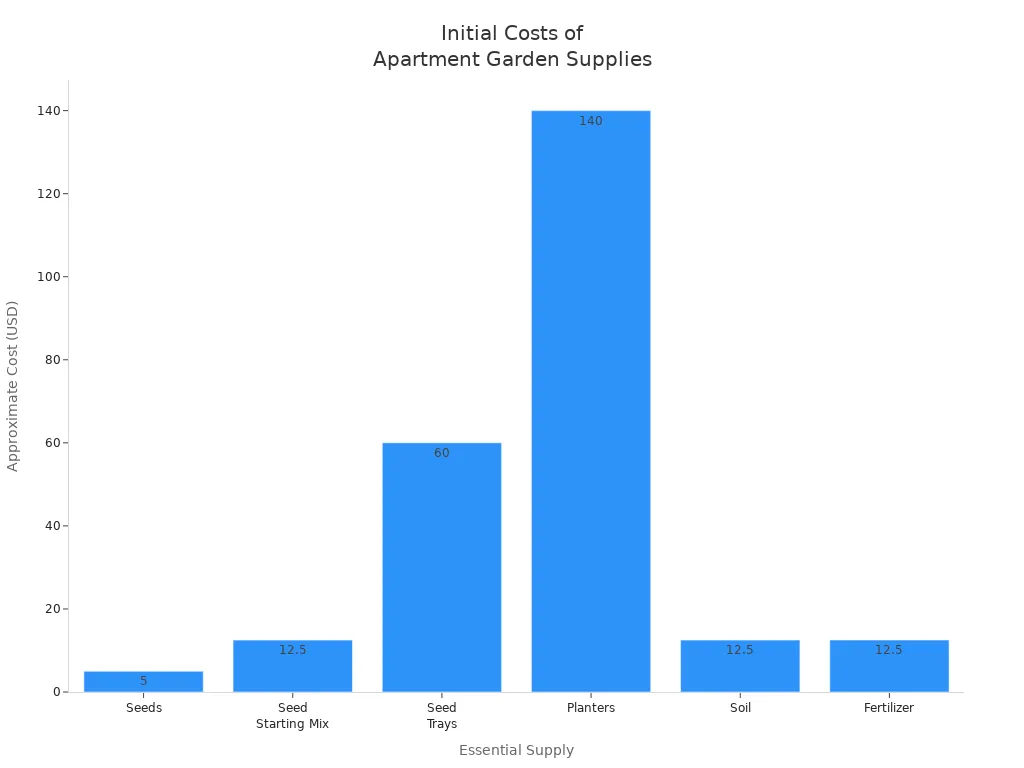
You can expect to spend about $100 to $200 to start apartment garden projects, depending on how many containers and trays you buy. If you want to save money, start with just a few pots and basic supplies. You can always add more as your indoor garden grows.
Tip: Always use potting soil or seed starting mix, not regular garden soil. Potting mixes drain better and help your plants stay healthy.
Planting Steps
You can start a garden from seeds or seedlings. Both ways work well for apartment gardening. Here’s what you need to do:
Gather your seed trays, containers, and seed starting mix. Make sure your containers have drainage holes.
Fill each container almost to the top with moistened seed starting mix. Leave a little space at the top.
Plant your seeds at the right depth. Check the seed packet for details. If you use seedlings, gently loosen the roots before planting.
Cover seeds lightly with more mix. Water until you see water drain from the bottom.
Place your containers in a warm, sunny spot. Cover with clear plastic or a lid to keep in moisture, but leave a small gap for air.
When seeds sprout, remove the cover. Give your plants 12–16 hours of light each day. You can use grow lights if needed.
Fertilize once a week after the first true leaves appear. Use a diluted liquid fertilizer.
Gently brush the tops of your seedlings or use a small fan to help them grow strong stems.
Thin out extra seedlings by snipping them at the soil line. This gives the remaining plants more room.
If you plan to move your plants outside, get them used to outdoor air by placing them outside for a few hours each day for a week.
Note: Label your seedlings so you know what you planted. Many young plants look alike!
Arrange Containers
Arranging your containers the right way helps your indoor garden thrive. You want your plants to get enough light and space to grow. Here’s what works best for apartment gardening:
Pick containers that fit your plants’ roots and have good drainage.
Place containers in sunny spots, like windowsills or balconies, where they get at least 6–8 hours of sunlight.
Use different sizes and shapes of containers—window boxes, baskets, and large pots—to make your space interesting and flexible.
Try vertical gardening by hanging planters on walls or balcony railings. Trellises help climbing plants grow up, not out.
Arrange containers so you can reach them easily for watering and care. Leave space between pots for air flow.
Mix tall and short plants in the same area. Put taller plants in the back and shorter ones in front to make sure all get light.
Use companion planting. For example, grow basil with tomatoes to save space and help both plants stay healthy.
Layer your garden by combining succulents, vegetables, and flowers. This makes your indoor garden look full and colorful.
Tip: Start with just a few containers. As you get more confident, add more plants and try new arrangements. You do not need to fill every space right away.
Starting an apartment garden is all about using what you have and growing at your own pace. You can enjoy fresh herbs, greens, and flowers even in a small apartment. With the right supplies, simple planting steps, and smart container arrangements, your indoor garden will soon become your favorite spot at home.
Apartment Gardening Tips
Watering and Feeding
Watering and feeding play a big role in apartment gardening. You want your plants to stay healthy and strong. Here are some tips for keeping your indoor garden happy:
Water container plants every day during hot months. Containers dry out faster than garden beds.
Use deep watering. Let water reach the roots, not just the surface.
Watch for signs of stress. If you see wilting or yellow leaves, water those plants right away.
Pause about 20 seconds per plant when watering annuals in summer.
Add compost or mulch to your containers. This helps hold moisture and gives your plants extra nutrients.
Try watering wands or hoses with shutoff valves for gentle watering.
Drip irrigation or soaker hoses work well for slow, deep watering.
Quality compost in your soil means your plants get the food they need. These apartment gardening tips help you grow strong, healthy plants.
Pruning and Pests
Pruning and pest control keep your apartment garden looking its best. Healthy plants need regular care. Here are some ideas for organic pest control and pruning:
Use companion planting to keep pests away. Some plants protect others.
Add ladybugs to your indoor garden. They eat pests like aphids.
Remove pests by hand if you spot them.
Spray natural solutions like neem oil or garlic water to control bugs.
Place barriers around your plants to block pests.
Improve soil with compost or worm castings for stronger plants.
Keep your plants healthy with good care. Healthy plants fight off pests better.
These apartment garden ideas help you avoid chemicals and keep your space safe.
Vertical and Container Gardening
Vertical gardening gives you more room for plants in small spaces. You can use tower gardens, stacked containers, or hanging pots. Here are some ways to use vertical space:
Stack containers to create a wall of greenery.
Use shelves, trellises, or hooks for hanging pots.
Choose plants like herbs, leafy greens, or climbing veggies for vertical setups.
Place taller plants at the bottom and shorter ones at the top for best sunlight.
Use good soil and self-watering planters for easy care.
Vertical and container gardening ideas help you fit more plants into your apartment. These tips make apartment gardening fun and creative. 🌱
Troubleshooting & Expanding
Common Problems
Every apartment gardener faces a few bumps along the way. You might notice your plants looking weak or not growing as expected. Here are some common issues and what you can do:
Not enough light often causes leggy growth, pale leaves, or leaf drop. Place your plants near south-facing windows for the brightest light. If you have only east or west windows, choose medium-light plants. North windows work for low-light plants like snake plant.
Use adjustable artificial lights, such as LED grow lights, if your space does not get enough sun. Give your plants 16-18 hours of artificial light daily if you have no outdoor light, or 12-14 hours if you get some natural light.
Raise your plants on stands or use adjustable fixtures to keep the right distance between the light and the leaves. Reflective surfaces, like white paint or aluminum foil, help bounce light back onto your plants.
Space your plants so they do not shade each other. Watch for signs like long stems or small leaves, which mean your plants want more light.
Too much light can scorch leaves. Move your plants back from the window or lower the light intensity if you see bleached spots.
Pests like aphids or spider mites sometimes show up. Remove them by hand or spray with a gentle soap solution.
Tip: Always choose plants that match the light in your apartment. This makes growing much easier!
Harvest and Grow More
Harvesting your herbs and veggies the right way keeps your garden healthy and productive. Try these simple steps:
Use a “cut-and-come-again” method. Snip outer leaves when they reach 2-3 inches, and let the inner leaves keep growing.
Harvest often. This encourages bushier plants and more leaves.
Never remove more than one-third of a plant at once. This helps your plants recover and keep producing.
Pinch off flower buds right away. This stops bolting and keeps your herbs tasting fresh.
Use clean scissors to cut from the outermost branches near the base. Pinch above a leaf node to help your plants branch out.
Prune dead or yellow leaves to keep your garden tidy.
Ready to try something new? Expand your indoor garden with leaf lettuce, tomatoes, cucumbers, bush squash, peas, radishes, beans, peppers, and eggplant. These varieties grow well in small spaces and give you lots to harvest.
Note: The more you harvest and experiment, the more confident you will feel as an apartment gardener!
Starting your apartment garden is simple when you follow these steps:
Pick a sunny spot with good drainage.
Choose plants that fit your space and climate.
Use containers with drainage holes and light potting soil.
Gather supplies like pots, soil, and watering tools.
Plant seeds or seedlings and water deeply.
Give your plants enough light and the right temperature.
Fertilize and watch for pests.
Start small with easy plants like herbs or greens. You will learn as you go and soon enjoy fresh harvests right at home. Celebrate each new leaf and bloom! 🌱
FAQ
What supplies do you need to start an apartment garden?
You need containers, potting soil, seeds or seedlings, and a watering can. Grow lights help if you have little sunlight. You can also use small hand tools and fertilizer for better results.
What plants grow best in small apartments?
Herbs like basil, mint, and chives grow well. Leafy greens such as lettuce and spinach also thrive. Compact veggies like cherry tomatoes and bush beans fit small spaces. Try snake plants or pothos for easy indoor greenery.
What should you do if your plants look unhealthy?
Check for enough light, water, and good soil. Look for pests or yellow leaves. Move your plant to a sunnier spot or use a grow light. Remove dead leaves and use organic fertilizer to boost growth.
What is the easiest way to water apartment plants?
Use a small watering can or a spray bottle. Water the soil until it feels moist but not soggy. Self-watering pots make it even easier. Always check the soil before adding more water.
What can you do if you have no balcony or windowsill?
Try vertical gardens, hanging planters, or shelves near any light source. Use grow lights if you have little sunlight. Microgreens and sprouts grow well on countertops or tables.


